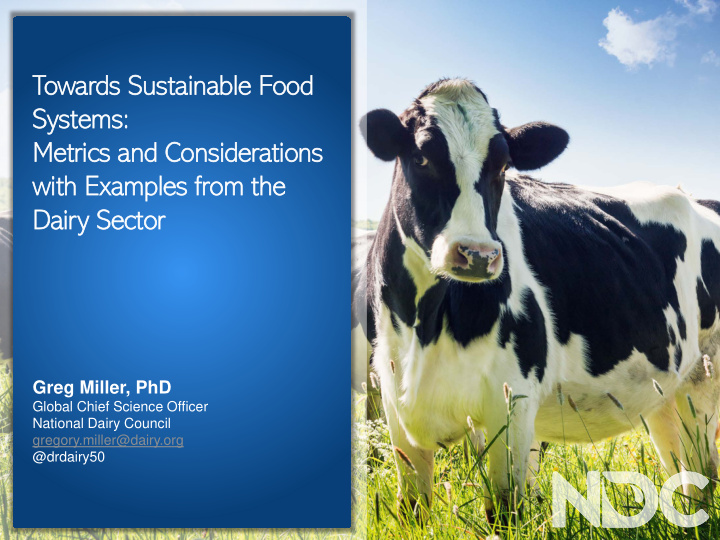



Towards Sus Sustain inable F Food Syst ystems: s: Metri rics a cs and nd Consi nsidera rations ns with E Exampl mples es f from om the e Dairy S Sector or Greg Miller, PhD Global Chief Science Officer National Dairy Council gregory.miller@dairy.org @drdairy50 NationalDairyCouncil.org 1 @NtlDairyCouncil
Bringing to life the dairy community’s shared vision of a healthy, happy, sustainable world, with science as our foundation NationalDairyCouncil.org 2 @NtlDairyCouncil
The Challenge Food production will need to increase Global middle class will triple by 2030 by 70% to feed the world by 2050 52% of projected world population 70% of world population will live in cities by 70% of suitable agricultural lands is could be exposed to severe water 2050 already in use or under protection scarcity by 2050 2009, FAO's Director-General on How to Feed the World in 2050. Population and Development Review, 35: 837–839. 6 NationalDairyCouncil.org 3 @NtlDairyCouncil
Malnutrition in the crosshairs The Global Nutrition Report http://www.sdg2advocacyhub.org/GNR2017 NationalDairyCouncil.org 4 @NtlDairyCouncil
NationalDairyCouncil.org 5 @NtlDairyCouncil
Nutrition and Food Systems A report by the High Level Panel of Experts (HLPE) on Food Security and Nutrition http://www.fao.org/3/a-i7846e.pdf NationalDairyCouncil.org 6 @NtlDairyCouncil
Food Systems: A Conceptual Framework NationalDairyCouncil.org 7 @NtlDairyCouncil
Sustainable diets as defined by FAO “Sustainable Diets are those diets with low environmental impacts which contribute to food and nutrition security and to healthy life for present and future generations. Sustainable diets are protective and respectful of biodiversity and ecosystems, culturally acceptable, accessible, economically fair and affordable; nutritionally adequate, safe and healthy; while optimizing natural and human resources.” Proceedings of the International Scientific Symposium, FAO and Biodiversity International 2012 BIODIVERSITY AND SUSTAINABLE DIETS UNITED AGAINST HUNGER, 3–5 November 2010, FAO Headquarters, Rome Gustafson et al. Sustainability . 2016 NationalDairyCouncil.org 8 @NtlDairyCouncil
Metrics to evaluate sustainability of food systems need to assess the multiple aspects Gustafson et al. Sustainability . 2016 NationalDairyCouncil.org 9 @NtlDairyCouncil
A Framework for Assessing Effects of the Food System To arrive at a decision whose benefits outweigh its risks, decision makers must carefully consider a broad range of effects and interactions across the health, environmental, social, and economic domains. See more at: http://iom.nationalacademies.org/Reports/2015/Food- System.aspx#sthash.mbeljiym.dpuf NationalDairyCouncil.org 10 @NtlDairyCouncil
Da Dairy Secto ector co r commitm tment t t to sus ustai ainab able p product uction NationalDairyCouncil.org NationalDairyCouncil.org 11 11 @NtlDairyCouncil @NtlDairyCouncil
Associations/Government Alliance Dairies Clauss Dairy Farms Dairy Fair Oaks Farms Cheese Processor Fiscalini Farms Foster Brothers Farm Gar-Lin Dairy Farm Dairy Graywood Farm Suppliers Haubenschild Farms Inc. Transport Sustainability Holsum Dairies Kooistra Farms Council Maddox Dairy MarBec Dairy Medeiros & Sons Dairy We commit to being leaders in Retail & Coops & McCarty Family Farms sustainability, ensuring the health QSR Farmers Mystic Valley Dairy and well-being of our planet, Nobis Dairy communities, consumers and the Prairieland Dairy Rovey Dairy industry Crop Simonson Dairy Community Spruce Haven Farm Production Triple A Farms Werkhoven Dairy 113 companies & 180 professionals in the Sustainability Council NationalDairyCouncil.org 12 @NtlDairyCouncil
Environment: Grounded in science • Life cycle science establishes baseline environmental footprint for U.S. Dairy • Peer-reviewed, published, and contributed to open-source National Agricultural Library • Greenhouse gas emissions of milk = 17.6 lbs. CO2 per gallon • Goal to reduce GHGe by 25% by 2020 U.S. Dairy is ~2% of U.S. GHGe, 5% total water withdrawal and <4% farmland occupation https://dairygood.org/content/2017/2016-us-dairy-sustainability-report NationalDairyCouncil.org 13 @NtlDairyCouncil
Environment: Reducing use of resources and lowering our impact • American farmers have succeeded in improving efficiency while caring for the environment. • Compared with 1944, the U.S. dairy industry now produces a gallon of milk using: 90% less land 65% less water And producing: 75% less manure 63% smaller carbon footprint USDA-NASS, http://www.nass.usda.gov/Data_and_Statistics/Quick_Stats_1.0/index.asp, Last accessed 25OCT10 USDA-ARS-AIPL, http://aipl.arsusda.gov/eval/summary/trend.cfm, Last accessed 26,OCT10 Capper J. Cady A. Bauman D. 2009. The environmental impact of dairy production; 1944 compared with 2007. Journal of Animal Science. 87:2160-2167 NationalDairyCouncil.org 14 @NtlDairyCouncil
Social and Environment: Animal Care FARM Program ~98% of U.S. milk comes from farms participating in the FARM Program NationalDairyCouncil.org 15 @NtlDairyCouncil
Social: Dairy’s role in cardiovascular and metabolic health recognized by Dietary Guidelines for Americans Advisory Committees 2010 and 2015 “Moderate evidence also indicates that “Consumption of dairy foods intake of milk and milk products is provides numerous health benefits, associated with a reduced risk of including lower risk of diabetes, cardiovascular disease and type 2 metabolic syndrome, cardiovascular diabetes and with lower blood pressure disease and obesity.” in adults.” 2015 Dietary Guidelines Advisory Committee Report 2010 Dietary Guidelines Advisory Committee Report NationalDairyCouncil.org 16 @NtlDairyCouncil
Economic: Milk and milk products are an economical source of nutrition Average cost per serving Meat, poultry, fish $0.63 Fruit $0.40 Vegetables $0.29 Dry beans, legumes nuts $0.26 Milk, milk products $0.26 Eggs $0.24 Grains $0.23 Sugars, sweets, beverages $0.23 Fats, oils, salad dressing $0.09 Values, 2001-2002 USDA CNPP database, Serving size, Reference Amount Customarily Consumed. Drewnowski. Nutr Rev; 2017 NationalDairyCouncil.org 17 @NtlDairyCouncil
Systematic approach to evaluating nutrition and food systems sustainability is required Need to think systemically! • Across different domains of a food system • Farm to consumer to farm • Multiple food and nutrition systems (not one diet nor one farm system!) Nascent research • Limited number of studies • Inconsistent or nuanced • Trade-offs among the domains of sustainability will likely have to be made. • Focusing on the environmental footprint of food as the sole standard for sustainable food patterns may run counter to human nutritional needs. NationalDairyCouncil.org 18 @NtlDairyCouncil
Thank you www.usdairy.com www.dairygood.org @DrDairy50 Miller and Auestad, Toward a sustainable dairy sector. Int. J Dairy Technology (2013). Volume 66, Issue 3, Article first published online: 20 MAY 2013 NationalDairyCouncil.org 19 @NtlDairyCouncil
Recommend
More recommend